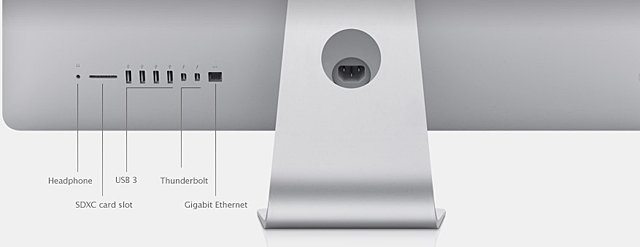MacBook (13-inch, Mid 2010): External ports and connectors
Here are some examples of your computer's ports which are used to connect power, headphones, or other devices (called peripherals) to your Mac.
Ports on a MacBook Pro with Retina display:

Ports on the back of an iMac:

Different kinds of ports
 MagSafe port: On a Mac notebook, this is where you connect the MagSafe power cable.
MagSafe port: On a Mac notebook, this is where you connect the MagSafe power cable. USB port: A wired external keyboard or mouse connects to your computer's USB port, as do many printers and USB flash drives (wireless keyboards, trackpads, and printers do not need to use a USB port—these use wireless Bluetooth or Wi-Fi technology). Learn more about using USB devices with Mac computers here.
USB port: A wired external keyboard or mouse connects to your computer's USB port, as do many printers and USB flash drives (wireless keyboards, trackpads, and printers do not need to use a USB port—these use wireless Bluetooth or Wi-Fi technology). Learn more about using USB devices with Mac computers here. Thunderbolt: Connect a Thunderbolt display, or connect a Mini DisplayPort to DVI, VGA, HDMI, or DisplayPort adapter. Also conect storage devices, video capture, firewire, and gigabit ethernet adapters directly to your Mac's Thunderbolt port. Got a new Thunderbolt display? See which Macs can connect to it.
Thunderbolt: Connect a Thunderbolt display, or connect a Mini DisplayPort to DVI, VGA, HDMI, or DisplayPort adapter. Also conect storage devices, video capture, firewire, and gigabit ethernet adapters directly to your Mac's Thunderbolt port. Got a new Thunderbolt display? See which Macs can connect to it. Audio ports: Connect your Mac to an audio system or to connect headphones or speakers using the audio ports.
Audio ports: Connect your Mac to an audio system or to connect headphones or speakers using the audio ports. HDMI port: You can use this port and an HDMI cable to connect to an HDTV's HDMI port, and use the TV as an external display. Note: You can also use an Apple TV and AirPlay Mirroring to turn your HDTV into an external display.
HDMI port: You can use this port and an HDMI cable to connect to an HDTV's HDMI port, and use the TV as an external display. Note: You can also use an Apple TV and AirPlay Mirroring to turn your HDTV into an external display. Ethernet port: If you connect to the Internet without Wi-Fi, you probably have a modem or router connected to your computer's Ethernet port. If your Mac doesn't have an Ethernet port but you need one, you can use the Apple USB Ethernet Adapter.
Ethernet port: If you connect to the Internet without Wi-Fi, you probably have a modem or router connected to your computer's Ethernet port. If your Mac doesn't have an Ethernet port but you need one, you can use the Apple USB Ethernet Adapter. FireWire port: Some Macs come with FireWire 400 or FireWire 800 ports for connecting peripheral devices such as external hard drives.
FireWire port: Some Macs come with FireWire 400 or FireWire 800 ports for connecting peripheral devices such as external hard drives.- Some Macs include a card reader slot ("SDXC card"), which makes it easy to transfer photos to and from your computer.
- A Kensington lock slot is available on certain Macs.
Which ports does my Mac have?
To learn which ports and connectors your Mac has:
- Find your computer's serial number.
- Go to Tech Specs.
- Enter your computer's serial number into the search box on the Tech Specs page. The search results should include your model of Mac.
- Click your computer to see its technical specifications, which include the ports and connectors.
I need more ports!
Some Macs have more ports than others. If you run into a situation in which your Mac doesn't have enough ports to connect all of your USB or FIreWire peripherals, consider getting a third-party hub.
There are many third-party USB and FireWire hubs on the market. These hubs work in the same way that a power strip allows you to plug in more electrical devices into a single socket. Companies such as Belkin and Kensington offer a wide variety of hubs.
If you want to create your own computer network, you can find plenty of Ethernet routers and hubs on the market too.